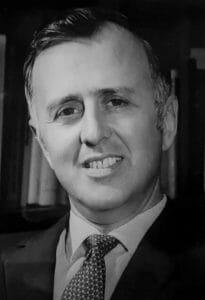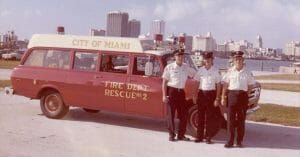After getting a degree in electrical engineering, Nagel changed his focus and became a medical doctor (anesthesiologist) in Miami, Fla. Nagel was fascinated by the concept of CPR — cardio-pulmonary resuscitation — which had been perfected by Dr. Peter Safar (Honorary Unsubscribe, Volume 2) in Pittsburgh, Pa., in 1957. As the new medical director for the Miami Fire Department’s Rescue Division, Dr. Nagel went to a meeting of the International Rescue and First Aid Association in 1964 — and heard from local firefighters that despite their efforts at CPR, none of their patients survived. Nagel realized that CPR wasn’t enough: defibrillation — electrically restarting the heart — was necessary, and the sooner the better. Some cities had doctors on ambulances to do that, but that was inefficient use of their time; rescuers in the field would need to do it, but before they could do that, there needed to be a way to take an EKG and instantly send it to a hospital to be read by a doctor to authorize the procedure. And, of course, the rescuers had to be trained to do it all in the field.

It took years to get it all together, but Nagel was the first to figure out how to send an EKG from the field to a hospital with a radio transmitter built into a wooden milk crate, and enabled rescuers to speak with a doctor. It weighed 35 pounds, but it worked. Why years? EKG telemetry and defibrillation weren’t really enough either: the rescue personnel needed to be able to give stabilizing cardiac drugs, and to do that they needed to learn how to start IVs. And it would be good for them to learn how to keep the patient’s airways intact, since heart attack victims have a tendency to vomit, which in unconscious people can easily compromise their breathing. Nagel started putting together a program to teach all of that and more, and coined the term for these new medical professionals: “paramedics”.

Paramedic training programs were already starting up, first in Pittsburgh in 1968 under Dr. Safar, and in Los Angeles, Seattle, and, under Dr. Nagel, Miami. The Miami program was delayed by local politicians: they didn’t think lay rescuers could perform such medical procedures. Nagel brought his firefighter trainees before Miami’s city manager and had them start an IV on him. Impressed, the city manager brought them before the City Commission to do the same demonstration. Nagel was given permission to proceed, and Miami Fire Rescue put six paramedics into the field in 1969. On January 15, 1972, a miracle happened: the show Emergency! went on the air on network television, showing how paramedics were already saving lives in the field. At the time there were only 12 paramedic squads in the entire country (and only two in Los Angeles County). “That was the biggest boost for emergency care and EMS,” Dr. Nagel said years later. “Suddenly cities across the country wanted paramedics. It created an appetite for EMS in this country like nothing else.”
In 1973, President Richard Nixon vetoed the EMS Systems Act, an effort to satisfy that appetite. Nagel went to Washington and drummed up so much support in Congress, it overrode Nixon’s veto. While he was at it, he lobbied for the 911 emergency number, already starting to be used, to receive funding for a national rollout. In 1974, Dr. Nagel jumped around a bit, but landed at a hospital in Winter Haven, Fla., and did some teaching through the University of Florida and the University of South Florida. On the side, he helped Israel start its own EMS system. Dr. Nagel died in Winter Haven on January 10, at 98.
